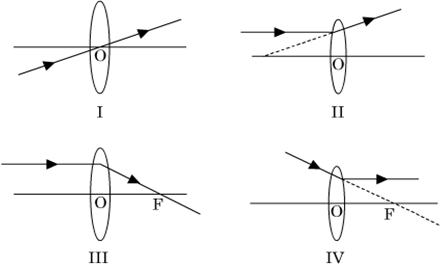 Multiple Choice Questions
Multiple Choice QuestionsA student is observing a diagram showing the path of a ray of light passing through a glass prism. He would find that for all angles of incidence the ray of light bends:
Towards the normal while entering the prism and away from the normal while emerging from the prism.
Away from the normal while entering the prism and towards the normal while emerging from the prism.
Away from the normal while entering as well emerging from the prism.
Away from the normal while entering as well emerging from the prism.
A.
Towards the normal while entering the prism and away from the normal while emerging from the prism.
The correct option is A.
The ray of light travels from rarer to a denser medium as it enters a glass prism. Hence, ray of light bends towards the normal.
A student was asked by his teacher to find the image distance for various object distances in case of a given convex lens. He performed the experiment with all precautions and noted down his observations in the following table:
|
S.No |
Object distance (cm) |
Image distance (cm) |
|
1 |
60 |
15 |
|
2 |
48 |
16 |
|
3 |
36 |
21 |
|
4 |
24 |
24 |
|
5 |
18 |
36 |
|
6 |
16 |
48 |
After checking the observation table the teacher pointed out that there is a mistake in recording the image distance in one of the observations. Find the serial number of observations having faulty image distance.
2
3
5
5
A student has obtained a magnified image of a flame on a screen using a convex lens. To draw the corresponding ray diagram to show the image formation, which of the following two rays whose paths after refraction are shown, should he select?

I and II
II and III
III and IV
III and IV
Study the following diagrams showing various stages of binary fission in Amoeba:
The correct sequence of these diagrams should be:

I, IV, III,II, V
I, III, IV, II, V
I, II, IV, III, V
I, II, IV, III, V
Identify the figures showing the process of budding in yeast.
I, II AND III
II, III AND IV
I, II AND IV
I, II AND IV
Which one of the following pairs of vegetables is an example of homologous structures?
Potato and sweet potato
Carrot and radish
Carrot and tomato
Carrot and tomato
Four students P, Q, R and S differently reported the following set of organs to be analogous:
P. Forelimb of a frog and forelimb of a lizard
Q. Forelimb of a bird and forelimb of a human
R. Wings of a parrot and wings of a butterfly
S. Wings of a bird and wings of a bat
The two students who have reported correctly are:
P and Q
Q and R
R and S
R and S
You are asked by your teacher to study the different parts of an embryo of a gram seed. Given below are the steps to be followed for the experiment:
I. Soak the gram seeds in plain water and keep them overnight.
II. Cut open a soaked seed and observe its different parts
III. Take some dry gram seeds in a petri dish
IV. Drain the excess water
V. Cover the soaked seeds with a wet cotton cloth and leave them for a day.
The correct sequence of these steps is:
III, 1, V, IV, II
III, I, II, IV, V
III, IV, V, I, II
III, IV, V, I, II
 Short Answer Type
Short Answer TypeWrite the number of vertical columns in the modern periodic table. What are these columns called?
Give the respective scientific terms used for studying:
(i) The mechanism by which variations are created and inherited and
(ii) The development of new type of organisms from the existing ones.
